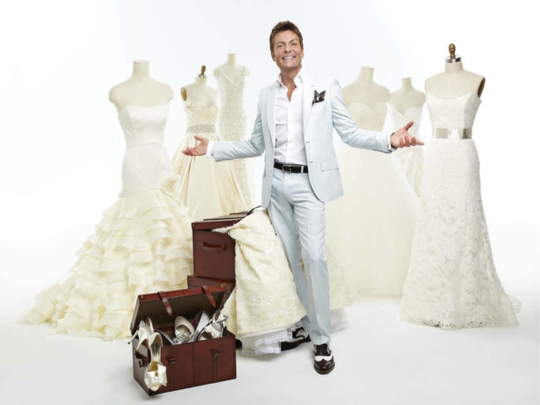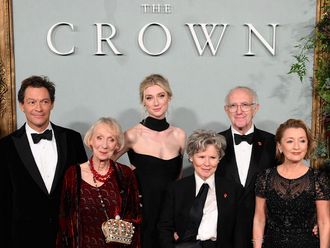
He no longer designs or sells, but in the wedding gown business, Randy Fenoli of Say Yes to the Dress on the TLC cable network has become a bit of a rock star. When Fenoli is in town, women, children and families seek him out to take photos with him or just to hear his always cheerful greeting, “Hello, beautiful.”
Open faced and immediately disarming, he bounds up to those he encounters with this welcome. Many who have worked with him say that there is no one better at making any woman feel special. In the course of his 13 seasons with the show, Fenoli has helped take the programme and Kleinfeld Bridal, the Manhattan store that is one of the show’s locations, to viewers in 130 countries. (The show is also shot in Atlanta and other cities.)
Viewers are often riveted as the featured bride and the group she has in tow wring their hands and yell their approval or disapproval of some of the dresses she tries on. At the end of the process, the bride, for whom the stakes can be no higher, must feel beautiful in the dress of her choice. Which is where Fenoli, 51, comes in.
He’s a “bridal gown whisperer”, said Samantha Press, a 25-year-old New Yorker and a regular viewer of the show.
Perhaps it is some pre-wedding sleight-of-hand, but Fenoli never actively steers the woman to one dress or another. Although he once was the design director at Kleinfeld he no longer works for the store, and as such he assures all who ask that he has no vested interest in whether the bride chooses a big-ticket item or a less expensive one. For him, the choice has to be what makes a woman feel gorgeous and fits her budget.
“He is good at discerning the dynamics of the family,” said Robert Verdi, a New York fashion stylist who had a show called Brides Gone Styled on TLC. “He is skilled at negotiating that territory. He’s like Switzerland: neutral.”
As each bride shops, Fenoli stands by her side, acting as her advocate, her adviser. He’s part therapist and part style guide.
“Randy is a phenomenon,” said Darcy Miller, the editorial director of Martha Stewart Weddings magazine. “He has a big personality and a passion for what he does.”
On an afternoon in August, TLC’s cameras were rolling at Kleinfeld Bridal, following Brittany Salvatore, 27. The first dress she fell in love with immediately elicited sneers from her grandmother, who claimed that it looked like a nightgown. Then her father entered the fray, urging her to try on a $16,000 (Dh58,770) dress, which led her mother to step in to remind them that the top of their budget was $5,000.
During the kerfuffle among Salvatore’s family, Fenoli spoke quietly and calmly to the bride — and to her peanut gallery.
“Let’s keep these dresses in mind and try on some more,” he told them. “I have pulled others to look at.”
And he had. After a few hours of Salvatore going in and out of the dressing room and trying on many styles, Fenoli was able to finesse the situation to a happy ending — without insulting anyone or insinuating his own taste into the decision.
“If you’ve ever been in therapy, you understand the process,” he said, adding, “a therapist doesn’t tell you what to do, and I don’t tell the brides what to do. I guide them.”
It’s always up to the bride to choose the dress she loves, he said. After many were examined by Salvatore — from organdy ballgown to short frocks with boned bodices — somehow, organically, it happened. Only then did Fenoli ask his famous question, one that has by now entered the American colloquial lexicon:
“Are you saying yes to the dress?”
“Yes!” she answered with conviction.
Everyone cheered, clapped, hugged and kissed. The tension vanished. The family left happy. Fenoli was on to his next project.
How does Fenoli perform his magic?
“He has a routine and a recipe that works, a great formula and template,” Verdi said. “The show is fun to watch. It’s popcorn TV: fun, fluffy and informative.”
Not surprisingly, because of this Fenoli has a wide following, from young girls to grandmothers.
“He seems so sincere and puts heart into tradition,” said Press, who has watched the show since she was a young teen even though she has no prospective groom in sight.
And then there’s Lilah Rousso, a 13-year-old fan in London. On her to-do list on a recent trip to New York with her parents was a visit to Kleinfeld’s in Chelsea, hoping to see Fenoli. He was not there that day, and she left disappointed.
“I’ve watched the show for two years,” she said in a telephone interview. “He seems so nice and never lets a bride leave unhappy.”
But the road to stardom has been winding. Fenoli said he owes much of his success with brides to his own former career as a female impersonator named Brandi Alexander: doing his own hair and makeup and designing and sewing his own dresses. In doing so, he said he learnt what it feels like to transform oneself into a beautiful bride.
In 1990, Brandi won the Miss Gay America pageant. Fenoli then used his prize money to jump-start his studies at the Fashion Institute of Technology, where he honed his skills as a designer and learnt the business. He then went on to design bridal wear in the 1990s for Paul Diamond, who owned the Diamond Collection.
It was Diamond’s wife, Vivian, who discovered Fenoli when she was judging a student competition at FIT.
“I needed a new designer at my company, and based on what my wife saw at the school, we hired Randy right out of that contest,” Diamond said.
“Before Vera Wang, before Amsale, bridal gowns were all the same; there were only a few styles, most with long sleeves, long trains and appliqués,” he noted. Fenoli’s first collection included a halter top, which helped put the young designer on the map.
“We did a trunk show with his first gowns at Kleinfeld’s when it was still in Brooklyn and from there Randy’s line exploded,” Diamond said.
But then Fenoli left New York to sell real estate in New Orleans. The pressure of coming up with a new line each season had “burned him out”, said Diamond, who noted that deep down he had always felt that Fenoli was more of a stylist than a designer.
“He’s an entertainer, an unbelievable personality,” Diamond added. “He is very believable; he has a way about him that draws you in immediately. He’s not a con artist, and he’s not a put-on. He’s the greatest salesman I’ve ever met.”
Then Hurricane Katrina hit, and Fenoli wanted to come back to New York. At about the same time, Kleinfeld Bridal moved from its original location in Brooklyn to Manhattan and needed a fashion director. Ronald Rothstein, an owner of the store, brought Fenoli in. Recalling Fenoli’s first appearance on the selling floor, Rothstein said, “It was like the pope had walked in.” Even though Fenoli had been absent from New York for some years, his customers remembered him.
“He knows the bride; the mothers love him,” Rothstein added. “He could customise a gown; he could sketch. His eye is unique.”
And now, eight years later, Fenoli is an independent contractor who also makes personal appearances at bridal shows and in salons in many countries.
“Why should I work for someone else in a full-time job when I can earn $20,000 for a four-hour personal appearance?” he asked.
He has just returned from Denmark, England and the Netherlands; in Amsterdam, he said, some 3,000 people lined up to meet him and have their photographs taken with him over the course of two days.
What does he think are the present trends in bridal gowns and veils?
“Today it’s whatever suits the bride,” he said. “It’s about her vision. Some women want to wear a gown with outside bones, a corset look. Others want halter tops or slips. Some are still traditional. But there’s everything from boho to ballgown.”
A gown has to suit a bride’s personality, he noted. While “younger women still want to look like princesses,” he said that “sexy is in — for the fiancé’s delight; low-cut, see-through, showing off the curves.”
And what about veils?
Blushers, which cover the face, are not seen too often today; Fenoli does not like them. But he loves a long veil attached low on the back of the head. “It’s so ethereal,” he said.
What would he choose if he had a daughter getting married? Sexy, flashy?
“No way,” he said. “She would look very traditional.”
— New York Times













